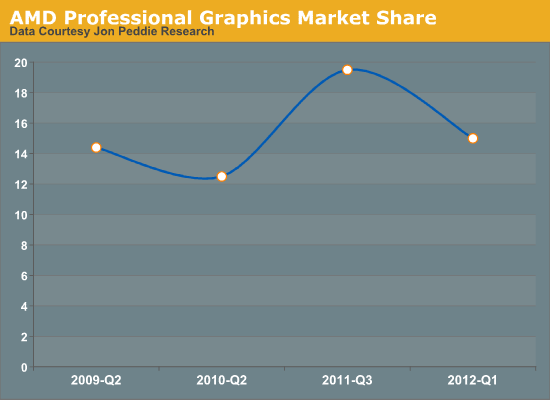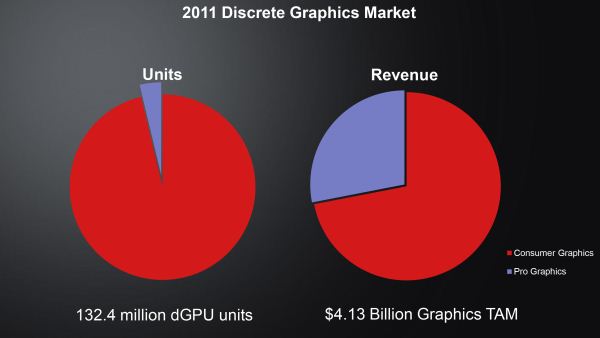The AMD FirePro W9000 & W8000 Review: Part 1
by Ryan Smith on August 14, 2012 4:00 AM ESTSetting the Scene: The Professional Graphics Market
Seeing as how this is our first professional video card review in quite some time, we wanted to spend a bit of time discussing the professional video card market in depth before diving into the features of AMD’s hardware. Because the professional graphics market is not particularly price-sensitive (unlikely the consumer market), how it operates is not particularly straightforward. Understanding the professional graphics market also sets the stage for understanding the importance of the FirePro W series; there’s more at stake than just beating NVIDIA’s cards.
The biggest reason that the professional graphics market is of great importance to NVIDIA and AMD isn’t just that it’s another market for them to sell products in, but because it’s not just another market. As we alluded to in our introduction, going by the volume of products shipped the professional graphics market is tiny. Even looking at revenue it’s far smaller than the consumer market. But what revenue hints at and what financial statements prove is that it’s profitable. Extremely profitable.
Neither AMD nor NVIDIA specifically break out their complete gross margins on a market segment basis – something that would be difficult to do since both rely on the same GPUs and R&D – but they are very straightforward in telling investors about the overall profitability of the professional market segments. To work with a simple example, take NVIDIA’s product lineup, where NVIDIA could profitably sell a GF110 GPU in the form of a GTX 580 at $500. Meanwhile the Quadro 6000 – a card containing the same GF110 GPU – was released at $5000, 10 times the price. Even after factoring in the unique costs of bringing a professional graphics product to market such as driver validation, support, and a higher individual unit cost, the professional graphics market is incredibly profitable. In the GPU market, just like most other technology markets, professionals will pay a much larger premium for specialized hardware.
The end result is that to make a significant profit in the desktop GPU market you need to hold a sizable share of both the consumer market and the professional market. The professional market will provide a low-volume, high-margin income stream, while the consumer market allows manufacturers to spread out R&D costs over a much larger number of products and to sell binned chips that would never meet professional standards.
But what happens if you don’t have a significant share of both the consumer and professional markets? Unfortunately, that would make you AMD.

Our apologies for the inconsistent data. JPR does not regularly release detailed market share data to the public
AMD’s professional graphics presence marks a continuing battle for the company. While in the consumer space they have 25% of the total market (including iGPUs) versus NVIDIA’s 15%, and in the discrete market they have 38% to NVIDIA’s 62%, in the professional graphics market they have only a 15% market share. This is better than the near-10% share they had a few years ago, but it’s below the near-20% share they reached last year, and far below where they would like to be.
As it stands AMD’s graphics division regularly turns out a small profit (in the form of operating income) every quarter, but they’re nowhere near NVIDIA’s profitability. It goes without saying that as a business AMD is always seeking to improve their profitability for their shareholders, however they also need to turn a profit to fund R&D of future products. Just as with CPU development, GPU development costs are continuing to rise with every generation, which makes the professional graphics market and its high margins all the more important. AMD is by no means in dire straits, but long-term a sub-20% market share is not where they want to be. A sub-20% market share means that AMD is struggling to stay relevant.











35 Comments
View All Comments
cjb110 - Tuesday, August 14, 2012 - link
No interest in the product unfortunatly, but the article was a well written and interesting read.nathanddrews - Tuesday, August 14, 2012 - link
I certainly miss the days of softmodding consumer cards to pro cards. I think the last card I did it on was either the 8800GT or the 4850. Some of the improvements in rendering quality and drawing speed were astounding - but it certainly nerfed gaming capability. It's a shame (from a consumer perspective) to no longer be able to softmod.augiem - Thursday, August 16, 2012 - link
I miss those days too, but I have to say I never saw any improvement in Maya sadly over the course of 3 different generations of softmodded cards. And I spent so much time and effort researching the right card models, etc. I think the benefits for Autocad and such must have been more pronounced than Maya.mura - Tuesday, August 14, 2012 - link
I understand, how important it is to validate and bug-fix these cards, it is not the same, if a card malfunctions under Battlefield3 or some kind of an engineering software - but is such a premium price necessary?I know, this is the market - everybody tries to acheive maximum profit, but seeing these prices, and comparing the specs with consumer cards, which cost a fraction - I don't see the bleeding-edge, I don't see the added value.
bhima - Tuesday, August 14, 2012 - link
Who has chatted with some of the guys at Autodesk: They use high-end gaming cards. Not sure if they ALL do, but a good portion of them do simply because of the cost of these "professional" cards.wiyosaya - Thursday, August 16, 2012 - link
Exactly my point. If the developers at a high-end company like Autodesk use gaming cards, that speaks volumes.People expect that they will get better service, too, if a bug crops up. Well, even in the consumer market, I have an LG monitor that was seen by nVidia drivers as an HD TV, and kept me from using the 1980x1200 resolution of the monitor. I reported this to nVidia and within days, there was a beta version of the drivers that had fixed the problem.
As I see it, the reality is that if you have a problem, there is no guarantee that the vendor will fix it no matter how much you paid for the card. Just look at t heir license agreement. Somewhere in the agreement, it is likely that you will find some clause that says that they do not guarantee a fix to any of the problems that you may report.
bwoochowski - Tuesday, August 14, 2012 - link
No one seems to be asking the hard questions of AMD:1) What happened to the 1/2 rate double precision FP performance that we were supposed to see on professional GCN cards?
2) Now that we're barely starting to see some support for the cl_khr_fp4 header, when can we expect the compiler to support the full suite of options? When will OpenCL 1.2 be fully supported?
3) Why mention the FirePro S8000 in press reports and never release it? I have to wonder about how much time and effort was wasted on adding support for the S8000 to the HMPP and other compilers.
I suppose it's pointless to even ask about any kind of accelerated infiniband features at this point.
With the impending shift to hybrid clusters in the HPC segment, I find it baffling that AMD would choose to kill off their dedicated compute card now. Since the release of the 4870 they had been attracting developers that were eager to capitalize on the cheap double precision fp performance. Now that these applications are ready to make the jump from a single PC to large clusters, the upgrade path doesn't exist. By this time next year there won't be anyone left developing on AMD APP, they'll all have moved back to CUDA. Brilliant move, AMD.
N4g4rok - Tuesday, August 14, 2012 - link
Providing they don't develop new hardware to meet that need. Keeping older variations of dedicated compute cards wouldn't make any sense for moving into large cluster computing. They could keep that same line, but it would need an overall anyway. why not end it and start something new?boeush - Tuesday, August 14, 2012 - link
"I find it baffling that AMD would choose to kill off their dedicated compute card now."It's not that they won't have a compute card (their graphics card is simply pulling double duty under this new plan.) The real issue is, to quote from the article:
"they may be underpricing NVIDIA’s best Quadro, but right now they’re going to be charging well more than NVIDIA’s best Tesla card. So there’s a real risk right now that FirePro for compute may be a complete non-starter once Tesla K20 arrives at the end of the year."
I find this approach by AMD baffling indeed. It's as if they just decided to abdicate whatever share they had of the HPC market. A very odd stance to take, particularly if they are as invested in OpenCL as they would like everyone to believe. The more time passes, and the more established code is created around CUDA, the harder it will become for AMD to push OpenCL in the HPC space.
CeriseCogburn - Wednesday, August 29, 2012 - link
LOL - thank you, as the amd epic fail is written all over that.Mentally ill self sabotage, what else can it be when you're amd.
The have their little fanboys yapping opencl now for years on end, and they lack full support for ver 1.2 - LOL
It's sad - so sad, it's funny.
Actually that really is sad, I feel sorry for them they are such freaking failures.